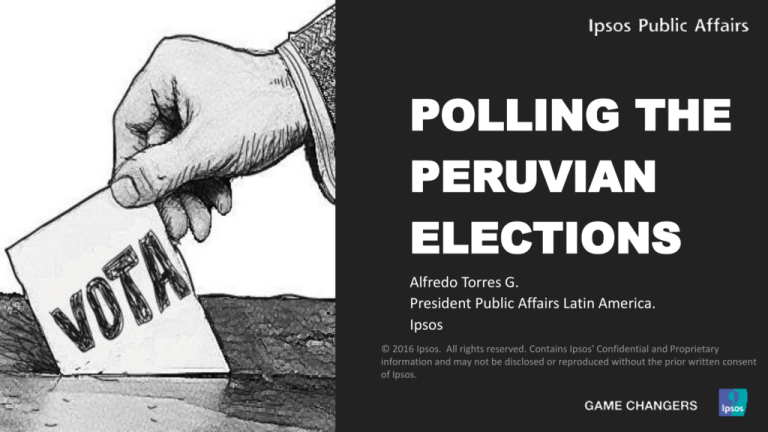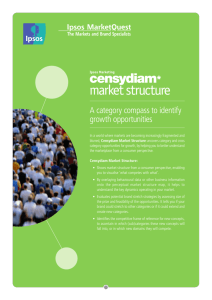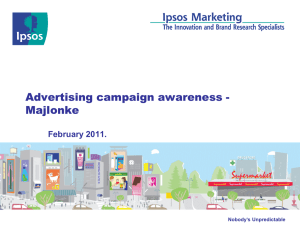
POLLING THE
PERUVIAN
ELECTIONS
Alfredo Torres G.
President Public Affairs Latin America.
Ipsos
© 2016 Ipsos. All rights reserved. Contains Ipsos' Confidential and Proprietary
information and may not be disclosed or reproduced without the prior written consent
of Ipsos.
CONTEXT
2
© 2015 Ipsos.
VOTING POPULATION DISTRIBUTION BY REGION AND AGE
Lima concentrates 35% of all Peruvian voters.
43%
11%
37%
24%
Lima
North
Center
35%
South
East/Jungle
20%
10%
20%
Source: ENAHO and Ipsos
3
© 2016 Ipsos.
ADULTS
Between 40 and 70 years
old
YOUNG ADULTS
Between 25 and 39 years
old
On average
40 years
old
57%
YOUTH
Between 18 and 24 years
old
ELDERLY
ADULTS: 6%
(optional vote)
71 years old or
more
POPULATION DISTRIBUTION BY SEL AND REGION (%)
Lima is a rhombus but Peru remains a pyramid.
Source: APEIM 2015
Elaboration: Ipsos Perú - (Big cities= More than 100,000 inhabitants)
4
© 2016 Ipsos.
PERÚ
LIMA
BIG CITIES
OTHER
URBAN
CITIES
RURAL*
A/B
13
25
11
3
0
C
25
40
29
15
2
D
24
26
34
34
7
E
38
9
26
48
91
COUNTRY CONNECTIVITY
Connectivity is still limited and is concentrated in SEL ABC and
the youth. Social networks are useful to start but not enough.
38% of all Peruvians
are connected to Internet
23% of all Peruvians
Source: Internet user and smartphone user profiles. Ipsos 2015
5
© 2016 Ipsos.
connect to the Internet
through a smartphone
EVOLUTION OF NATIONAL ISSUES
Crime is even more troubling today than 5 years ago. On the
other hand, concerns about the economy reappear.
(%)
Crime / Lack of security
70
Corruption
Unemployment
49
31
28
22
13
1990
2000
2010
2015
Which of the following are in your opinion the three main problems of the country today? (with card)
All respondents in urban areas: 1235
January 2016
6
© 2016 Ipsos.
2016
Poverty
Cost of living / high prices
Education
VOTING
INTENTIONS
7
© 2016 Ipsos.
VOTING INTENTIONS EVOLUTION, FEBRUARY 2016
Keiko holds a firm position at the top. The surprise: Within only two
months, Julio Guzman jumps from social networks to the streets.
40%
35
Keiko Fujimori
30%
Pedro Pablo Kuczynski
20%
10%
5
0.5
%
JUL-13
JUL-14
DIC-14
ABR-15
JUL-15
OCT-15
NOV-15
DIC-15
If tomorrow were presidential elections and the following candidates ran ... for who would you vote? (With card)
All respondents in urban and rural areas: 1831
Source:
Ipsos
untilIpsos.
January 2016.
8
© 2016
February: DATUM and CPI
ENE-16
16
Alan García
11
10
César Acuña
5
Julio Guzmán
FEB-16
¿WHO IS WHO?
9
© 2016 Ipsos.
KEIKO
FUJIMORI
10
© 2016 Ipsos.
• Liabilities of
her father's
government
• Achievements
of her father's
government
• Associated
with firm
hand and
order
• Strong in
popular
sectors (SEL
DE)
• Very strong in
rural sector
• Novelty of a
female
candidate
• Associated
with
corruption
• Lack of work
experience
• Questionable
environment
• Questionable
financing
PPK
11
© 2016 Ipsos.
• Experience
managing
government’s
office
• Economist: career
considered ideal
for a president
• No corruption
charges
• Associated with
good
international
relations
• Image of
successful
entrepreneur who
has grown
through his effort
• Strong only in
Lima and SEL
AB
• Accusations
of lobbying
and ensuring
private
interests
• Dual
citizenship
• Advanced age
• Candidate of
the rich
ALAN
GARCÍA
12
© 2016 Ipsos.
• Accusations of
being corrupt
• Experience in
government
management
• Thought of as a
leader
• Receives strong
party
reinforcement
• Excellent public
speaker
• Economic
growth in his
second term
• Accusations of
ensuring
private
interests
• Belongs to a
traditional
political party
• Disastrous first
government
• Seen as
arrogant and
intolerant
CÉSAR
ACUÑA
13
© 2016 Ipsos.
• Experience in
municipal and
regional
management
• Proximity to
the Peruvian
average
• Strong in
popular
sectors (SEL
DE)
• Origin in
Peruvian
provinces
• Image of
successful
businessman,
emerged from
below
• Accusations
of plagiarism
in doctoral
thesis and
stealing the
authorship of
a book
• Populism and
clientelism
• Accusations
of domestic
violence and
sexual
relations with
minor
• Questionable
businesses:
Universities
• Difficulties
with public
speaking
JULIO
GUZMÁN
14
© 2016 Ipsos.
• Strong mainly
in SEL ABC
• Popular among
young voters
• Economist:
career
considered
ideal for a
president
• No corruption
charges
• Seen as new in
politics.
• Not associated
with the
traditional
political parties
• Young and
energetic
• Accusations of
lobbying and
ensuring
private
interests
• Associated
with
improvisation
• No experience
in political
office
• Contradictions
in his
statements
ACCUSATIONS AGAINST JULIO GUZMÁN
Guzman's candidacy is in jeopardy for not fulfill basic requirements
such a quorum for the assembly that changed the bylaws of its party
Assembly to
approve new
statute
10/10
/15
TPP try to enroll
their new statute
Primaries where
Guzman is elected
TPP inscribes his
National Electoral
Court
18/12
/15
20/12
/15
21/12
/15
TPP arguments:
The ROP is based on a March 2015 membership list. It
doesn’t take into account members enrolled between March
and October.
Counting the new members, the assembly meets the 20%
required quorum and turns into a valid assembly.
15
© 2016 Ipsos.
TPP registers its
Electoral Executive
Committee
22/12
/15
JNE ratifies ROP
decision
complicating
Guzman candidacy
Registration of TPP
formula
23/12
/15
ROP said 10/10
assembly was not
notified at all
enabled members,
and there was no
quorum (5 out of
55, and 9 who were
not enrolled in TPP)
10/01
/16
28/01
/16
ROP annulled the
20/12 assembly
where Guzman was
elected
16/02
/16
Implications and following weeks:
-
-
-
17
The ROP resolution does not leave out the candidacy of Julio Guzmán.
The evaluation revolves around modifying the registry of Todos por el Peru, it‘s not
against the registration of the presidential or congress formula, which are currently
being validated by the Special Electoral Jury (JEE).
Although they are independent processes, they are tied, and it is probable that the
JEE decides to strike out the presidential and congressional list after learning the
decision against Todos Por el Peru registration.
If the JEE fails against the Guzman’s candidacy, TPP will appeal arguing that its
constitutional right to political participation is above the JNE and ROP election rules
and requirements.
This appeal and its solution could have up to four weeks, and may be decided 10
days before the election.
© 2015 Ipsos.
LEARNINGS
FROM THE
PAST 25
YEARS
18
© 2015 Ipsos.
1. THE
SOCIOECONOMIC
LEVEL
MATTERS
19
© 2015 Ipsos.
VOTE COMPOSITION BY SEL FOR EACH CANDIDATE
Fujimori and Acuña have a wide preference in SEL DE. PPK, Guzman
and Garcia are strong in SEL ABC.
ABC
KEIKO FUJIMORI
CÉSAR ACUÑA
PEDRO PABLO KUCZYNSKI
ALAN GARCÍA
JULIO GUZMÁN
44
56
50
50
72
28
69
31
89
If tomorrow were presidential elections and the following candidates ran... for who would you vote? (With card)
All respondents in urban and rural areas: 1831
Source: Ipsos until January 2016.
20
© 2016 Ipsos.
(%)
DE
11
2. THE VOTE
COMES
FROM DEEP
WITHIN
PERU
21
© 2015 Ipsos.
ELECTION RESULTS 2011
(%)
In 2011, Humala lost in Lima but won in the interior
of the country.
Ollanta Humala
20
38
24
Keiko Fujimori
Pedro Pablo Kuczynski
Otro candidato
Source: ONPE. Official results 2011, first round.
Ipsos Perú. Quick count, presidential elections 2011 first round
22
© 2016 Ipsos.
32
22
Total
25
18
28
13
26
24
Lima
Interior
30
BIRTHPLACE OF THE LEADING CANDIDATES
65% of all voters are found in Peruvian provinces. These
voters may sympathies with the only provincial candidate.
Cajamarca, 1952.
11%
Lima, 1938.
24%
Lima
North
Center
35%
South
East/Jungle
Lima, 1949.
10%
Lima, 1970.
20%
Lima, 1975.
23
© 2016 Ipsos.
Source: JNE
3. THE VOTE
GOES OUT
FOR THE
MIDDLEAGED
CANDIDATE
24
© 2015 Ipsos.
AGE OF ELECTED CANDIDATES IN RECENT ELECTIONS
In recent years, the elected candidates were always around
50 years, with the exception of Garcia in his 2nd term.
1995
1990
Elected at
age 56
Re-elected
at age 56
Elected at
age 51
2001
Elected at
age 55
25
© 2016 Ipsos.
2011
2006
Elected at
age 50
AGE OF THE LEADING CANDIDATES
In terms of age, Fujimori and Guzman are closest to the
average Peruvian, and the age of the ideal president.
1952. Age 63.
11%
1938. Age 77.
24%
Lima
North
Center
35%
South
East/Jungle
1949. Age 66.
10%
1970. Age 45.
20%
1975. Age 40.
26 for age:
© 2016
Ipsos.
Source
ENAHO
Source ideal president average age: Ipsos, October 2009
Average age for the
ideal president:
43 years old
Peruvian elector
average age:
40 years old
4. PEOPLE
VOTE FOR
THE
CENTER
CANDIDATE
27
© 2015 Ipsos.
LEFT-RIGHT POSITIONING 2006
In 2006 Alan Garcia won for being the most in the center.
75
50
25
0
Extreme
left
2
3
4
5
6
7
On a scale of 1 to 10 where 1 is "extreme left" and 10 is "extreme right", where would you place...? (With card)
Base: Total respondents who know the terms left and right in politics.
28
© 2016 Ipsos.
8
9
Extreme
right
(%)
LEFT-RIGHT POSITIONING 2011
In 2011, Humala's move to the center allowed him to
beat Fujimori who is associated with the right.
75
50
25
0
Extreme
left
2
3
4
5
6
7
On a scale of 1 to 10 where 1 is "extreme left" and 10 is "extreme right", where would you place...? (With card)
Base: Total respondents who know the terms left and right in politics.
29
© 2016 Ipsos.
8
9
Extreme
right
(%)
LEFT-RIGHT POSITIONING 2016
Currently, Acuña and Guzmán would be the center candidates; PPK
and Alan Garcia would be the furthest on the right. This reduces their
chances.
75
Citizen: 5
50
25
0
Extreme
left
2
3
4
5
6
7
On a scale of 1 to 10 where 1 is "extreme left" and 10 is "extreme right", where would you place...? (With card)
Base: Total respondents who know the terms left and right in politics.
30
© 2016 Ipsos.
8
9
Extreme
right
5.
THE DEMAND
FOR CHANGE IS
ONE OF THE
MAIN
MOTIVATIONS
OF THE VOTE
31
© 2015 Ipsos.
1980-2011
The change in history
1980
1985
1990
2001
2006
2011
32
© 2016 Ipsos.
•The failure of the military determined the return of Belaunde in 1980. Citizens decided to return to “taita”
Belaunde.
•Belaunde’s disappointing second government led Peru to vote for a young Alan Garcia, representing renewal and
energy.
•The crisis under Garcia’s government led Peru to vote for the Great Shift preached by Mario Vargas Llosa. Instead of
giving into his radical proposal, the population opted for the moderate change, represented by Fujimori.
•Fujimori's authoritarianism triggered the people to elect a democratic Alejandro Toledo, who offered more jobs and
fighting poverty.
•The frustrations caused by Toledo led to a polarization between Lourdes Flores – Ollanta Humala. The result: Alan
Garcia elected as the “responsible change”.
•As president Garcia was perceived as an intelligent, but arrogant and dishonest person. This paved the way for
Ollanta Humala who was seen as a simple and honest candidate.
Ollanta Humala’s profil
(with card– main answers)
Humble
(21%)
Near to the
people (17%)
Strengths
No has no leadership
skills (50%)
He does not qualified
for the position(46%)
He does not
tell the truth
(31%)
Working man
(14%)
He does not
have good
ideas (22%)
Good ideas
(13%)
Source: Ipsos Perú, national urban survey
May 2014
33
© 2016 Ipsos.
Solidary/
humanitarian (10%)
Does not
know how to
listen (17%)
Weaknesses
IDEAL PRESIDENT FEATURES
Given Humala’s shortcomings, in these elections, voters look for
leadership skills and vision of the future as well as honesty.
2011-2015
TENER LIDERAZGO
45
24
42
SER HONRADO
TENER VISIÓN DE FUTURO
31
31
29
30
TENER CAPACIDAD
TENER EXPERIENCIA
26
25
22
SER DEMOCRÁTICO
SER TRABAJADOR
TENER SENSIBILIDAD SOCIAL
SER SINCERO
SER BUEN COMUNICADOR
Informe de Opinión – Marzo 2011, Octubre 2015
34
© 2016 Ipsos.
17
16
15
12
12
47
38
31
2015
2011
6. CAMPAIGNS
ARE DEFINED AT
THE END.
PERUVIANS ARE
ATTRACTED TO
UNDERDOGS.
35
© 2015 Ipsos.
VOTING INTENTIONS EVOLUTION, 2006
In 2006, Lourdes started out as first. Ollanta began to grow 4 months before the
elections, and took the lead in March. Alan passed Lourdes only one week before
the election.
2 months before
the elections
40%
1 month
before the
elections
30%
20%
(%)
30.6
Ollanta Humala
24.3
23.8
Alan García
16
Lourdes Flores
Martha Chávez
10%
7.4
5.8
%
DIC-05
ENE 13
ENE 27
FEB 10
FEB 24 MAR 10 MAR 17 MAR 24 MAR 31 ABR 08
If tomorrow were presidential elections and and the following candidates run ... for whom would you vote? (With card)
36
© 2016 Ipsos.
ONPE
Valentín Paniagua
VOTING INTENTIONS EVOLUTION, 2011
In 2011, Toledo started as the favorite. Humala began to grow in
February and ranked as first by March. Keiko remained second.
2 months before
the elections
40%
(%)
1 month
before the
elections
31.6
30%
Ollanta Humala
Keiko Fujimori
23.5
20%
18.5
15.6
9.8
10%
%
DIC-10
17-ENE
13-FEB
27-FEB
13-MAR
20-MAR
27-MAR
03-ABR
09-ABR
If tomorrow were presidential elections and and the following candidates run ... for whom would you vote? (With card)
37
© 2016 Ipsos.
ONPE
Pedro Pablo Kuczynski
Alejandro Toledo
Luis Castañeda
7. THE
DIFFERENCE
BETWEEN
FIRST AND
SECOND
CANDIDATE IN
THE FIRST
ROUND IS
IMPORTANT
38
© 2015 Ipsos.
RESULTS FIRST AND SECOND ROUND (1985 – 2011)
If the difference in the 1st round is small, it is possible to turn around
the result.
First
Second
62
33
38
29
1ST ROUND
2ND ROUND
1990
39
© 2016 Ipsos.
47
31
53
24
1ST ROUND
2ND ROUND
2006
RESULTS FIRST AND SECOND ROUND (1985 – 2011)
If the difference in first round is large, it is very difficult to turn
around the result.
First
Second
53
37
32
26
1ST ROUND
2ND ROUND
2001
40
© 2016 Ipsos.
51
47
48
24
1ST ROUND
2ND ROUND
2011
SECOND ROUNDS 2016 (DATUM)
The rival that poses that highest threat to Keiko Fujimori in a possible
second round is Julio Guzman.
48
Keiko Fujimori
César Acuña
22
B/V/NP
51
Keiko Fujimori
Alan García
16
B/V/NP
In a second round between… for whom would you vote?
41
© 2016
Ipsos. and rural areas:
All respondents
in urban
February: DATUM
37
PPK
30
B/V/NP
44
Keiko Fujimori
33
19
Keiko Fujimori
42
Julio Guzmán
41
B/V/NP
17
FUJIMORI ELECTORAL POTENCIAL AND ANTIVOTE EVOLUTION
To win the second round, Keiko Fujimori has to continue reducing her
antivote and win by more than a 15 point difference.
Definitely vote for him / her
Definitely not vote for him / her
Could vote for him / her
Don't know him/ her
ene-16
32
dic-15
27
22
oct-15
29
23
18
15
What is your attitude towards the candidacy of ...? (With card)
All respondents in urban and rural areas: 1831
January 2016
© 2016 Ipsos.
7
24
29
mar-11
42
25
nov-15
abr-11
Probably would not vote for him / her
DK/NA
25
20
34
7
40
6
6
14
13
2
46
2
40
12
39
12
40
3
1 5
CONCLUSIONS
43
© 2015 Ipsos.
•
IMMOVABLE KEIKO : So far, Fujimori is for sure in the second round. His opponent
is unknown but a great desire for renewal is perceived in the electorate.
•
CONVERGENT CONTENTS: The campaign issues are security, fight against
corruption and economy. However, the electorate doesn’t perceive big differences
between the proposals of the different candidates.
•
DIVERGENT IMAGES: Fujimori stands out for her closeness to the people;
Guzman because he represents a renewal; PPK because is a technocrat; Acuña
because of his popular-emerging trajectory. Garcia for his expertise
•
GUZMAN IN COMA: Guzman is with one foot out of the competition. If he
resurrects, he could reach the second round with very good choice. If he is left out,
many of his supporters will look for a new "underdog".
•
FROM INFORMAL TO INMORAL: If Guzman finishes out of competition, the
pressure to oust Acuña of the race will be strong. The Peruvian - left and right establishment considers him morally disqualified to govern.
THANKS!
45
© 2016 Ipsos.






